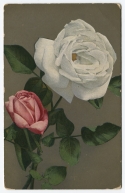Estonian War of Independence. November 1918 - February 1920
An important part of the establishment of the Estonian state in 1917–1918 has been played by the national army units, with whose support the idea of Estonian independence was realized. The national army units became the basis for the army of independent Estonia - thus the real forces necessary for our War of Independence were concentrated in the homeland and the foundation for the organization of the people's self-defense was laid.
In 2018, 100 years will pass since the beginning of the Estonian War of Independence. The museum's collection of postal history includes nearly 700 postcards sent during the war years with stamps used in various military units.
The first part of the exhibition takes us to the years 1917–1919:
- Establishment of Estonian national army units in 1917–1918
- Field post in the Estonian War of Independence in 1919
Old letters are part of our cultural and postal history. The exhibition focuses on postal history, ie stamp prints. But there is also exciting research for those interested in history and postcards.
Enjoy and watch!
Enjoy and watch!
In the toolbar, under the information button, you will find the stamp imprint text ( in italics ), historical background information and explanations about the image.


The armored train "Captain JRW"
The armored train was originally called the Wide Gauge Armored Train No. 1 (LRSR No. 1). After the death of the first commander of the armored train, captain Anton Irv, in a battle near Egle railway station in northern Latvia on April 27, 1919, the armored train was named Captain Irv after Anton Irv.
Mirožski monastery, Pihkva
The armored train was originally called the Wide Gauge Armored Train No. 1 (LRSR No. 1). After the death of the first commander of the armored train, captain Anton Irv, in a battle near Egle railway station in northern Latvia on April 27, 1919, the armored train was named Captain Irv after Anton Irv.
Mirožski monastery, Pihkva


The commander of the 2. narrow gauge armored train
The narrow-gauge armored train no 2 was built in the same way as the armored train no 3 by order of captain Johan Pitka in Tallinn at the end of December 1918 and the beginning of January 1919. The train was 7 wagons long, with one 55 mm old sea cannon and six machine guns. The train was formed by lieutenant captain Paul Laamann, who himself became the first commander of the train.
Valka, Livonia, Knight market (Latvia)
The narrow-gauge armored train no 2 was built in the same way as the armored train no 3 by order of captain Johan Pitka in Tallinn at the end of December 1918 and the beginning of January 1919. The train was 7 wagons long, with one 55 mm old sea cannon and six machine guns. The train was formed by lieutenant captain Paul Laamann, who himself became the first commander of the train.
Valka, Livonia, Knight market (Latvia)


Wide gauged armored train no 5 / For letters
The wide-gauge armored train no 5 was founded on the 16.03.1919, and was sent to the front on the 18.03.1919 under the leadership of Ernst Grasmandorf.
Photo up: armored tran no 3, artillery platform "Tasuja"
down: armored train no 5, artillery platform "Võitleja"
The wide-gauge armored train no 5 was founded on the 16.03.1919, and was sent to the front on the 18.03.1919 under the leadership of Ernst Grasmandorf.
Photo up: armored tran no 3, artillery platform "Tasuja"
down: armored train no 5, artillery platform "Võitleja"


Armored trains Division /Music commando
The first directive of the division headquarters was published on the 20.02.1919, announcing that all wide and narrow gauge armored trains, supply trains, repair trains, riding and music teams would be merged into the Armored Trains Division.
Large market, Dorpat (Tartu)
The first directive of the division headquarters was published on the 20.02.1919, announcing that all wide and narrow gauge armored trains, supply trains, repair trains, riding and music teams would be merged into the Armored Trains Division.
Large market, Dorpat (Tartu)
Exhibition committee
Compiler: Eve Aab
Consultant: Ants Linnard, Chairman of the Postal Museum Friends Association
Photos: Arp Karm
Editor: Tuuli Kaalep
Toimetaja: Tuuli Kaalep
Compiler: Eve Aab
Consultant: Ants Linnard, Chairman of the Postal Museum Friends Association
Photos: Arp Karm
Editor: Tuuli Kaalep
Toimetaja: Tuuli Kaalep
References and sources
- Andreller, Jüri, Eduard Laaman and Johannes Poopuu. Armored Trains Division in the War of Independence. Tallinn Grenader, 2009.
- Estonian War of Independence XI.1918 - II.1920. Health care part. Tallinn, 1921.
- Estonian War of Independence 1918–1920. Parts I to II. Popular scientific publication of the Commitee on the History of the War of Independence. Tallinn Committee on the History of the War of Independence, 1937.
- Grosschmidt, Eduard. Under the skull mark. Tartu K / Ü Loodus, 1935.
- Guide to collecting materials from the history of the War of Independence. Chronology of events in the struggle period of Estonian national independence 1917–1920. Tallinn Committee on the History of the War of Independence, 1936.
- Kurvits, Oskar (ed.). Album of Estonian National Armed Forces II. Tallinn Society „1. Estonian Brigade” edition, 1937
- Kurvits, Oskar. Creation of Estonian national army units 1917–1918. Society „1. Estonian Brigade ”publishing house, 1930.
- Reinvaldt, Edvin and Tõnis Kint (assembly). Wide gauge armored train no. 2 In the War of Independence. Stockholm Foreign Estonia & EEA, 1972.
- Traksmaa, August.A brief history of the War of Independence.Tallinn: Publication-Private Limited Company "Cultural Community", 1939.

















